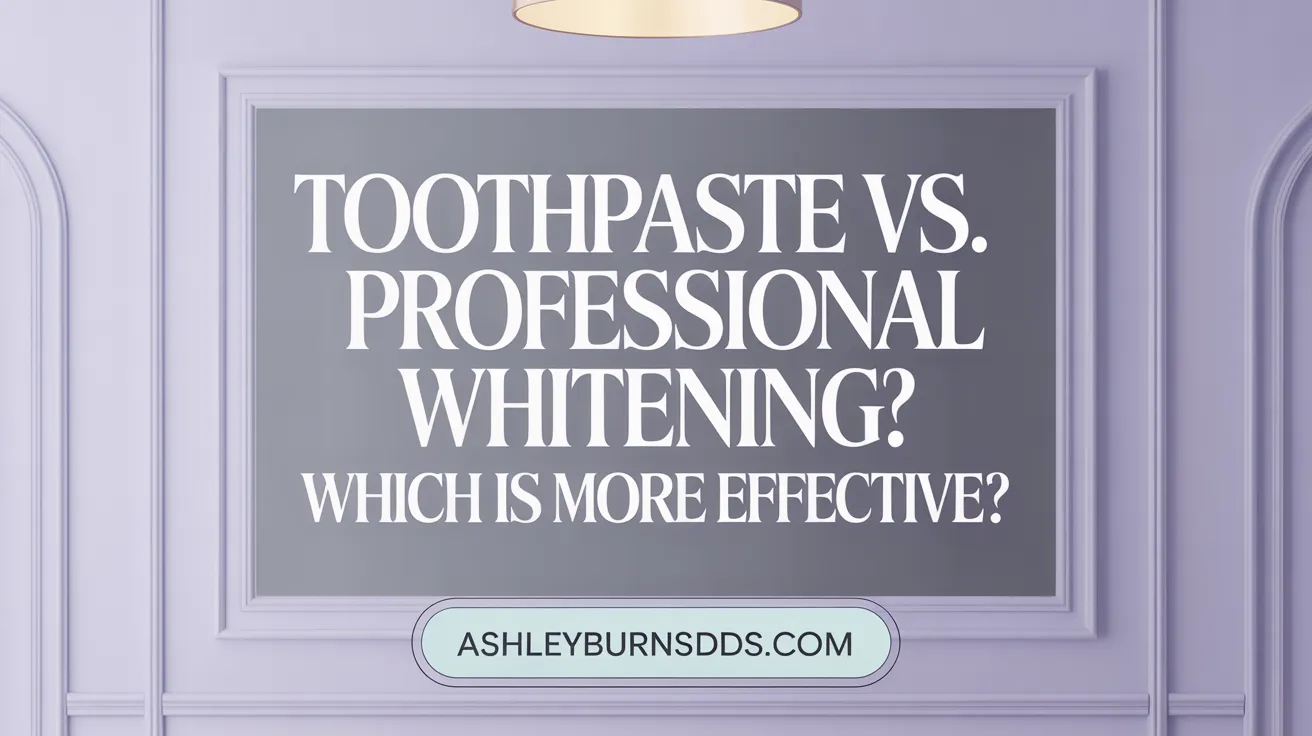Understanding Whitening Options: A Science-Based Overview
Teeth whitening has become a popular cosmetic dental procedure, with options ranging from everyday whitening toothpastes to professional bleaching treatments. Understanding the scientific evidence behind these methods is essential for making informed decisions about their effectiveness, safety, and long-term impact on dental health. This article delves into research findings, expert opinions, and clinical studies to compare whitening toothpastes and professional whitening treatments comprehensively.
Comparing the Effectiveness of Whitening Toothpastes and Professional Treatments

What does scientific evidence say about the effectiveness of whitening toothpastes compared to professional whitening treatments?
Scientific studies consistently show that professional whitening treatments are more efficient at whitening teeth than over-the-counter whitening toothpastes. These professional procedures utilize higher concentrations of bleaching agents, primarily hydrogen peroxide or carbamide peroxide, often ranging from 25% to 40%. Such potent formulations can penetrate deeper into enamel and dentin, effectively breaking down intrinsic stains and producing faster, more noticeable results.
A typical in-office whitening session, often completed within an hour, can lighten teeth by several shades almost immediately. These treatments are administered under the supervision of dental professionals, carefully monitoring for side effects like sensitivity or gum irritation, and ensuring the safety of the procedure.
In contrast, whitening toothpastes operate mainly through mild abrasives that mechanically remove surface stains and contain low levels of peroxide, usually less than 1%. While they can contribute to gradual surface stain removal, their whitening effect tends to be subtle, often only brightening teeth by about one to two shades over a period of weeks or months. They are primarily considered maintenance products to preserve the results of professional whitening rather than standalone solutions.
Meta-analyses and clinical trials further underline this difference. Studies reveal that while whitening toothpastes can improve the aesthetic look of teeth modestly, their capacity to change intrinsic discoloration or deeper stains is limited. Conversely, professional treatments can achieve significant color enhancements and longer-lasting results, which can often be maintained with the use of whitening toothpaste over time.
Overall, for individuals seeking dramatic and rapid whitening, professional in-office procedures are the superior option. Whitening toothpastes serve well for daily maintenance and minor surface stain removal but should not be relied upon for substantial whitening effects.
Safety Considerations and Risks of Whitening Methods

What are the safety considerations and risks associated with whitening toothpastes and professional whitening procedures according to research?
Research shows that both whitening toothpastes and professional whitening treatments are generally safe when used according to instructions and under supervision. Whitening toothpastes typically contain mild abrasives and peroxides like hydrogen peroxide or carbamide peroxide. They help remove surface stains and lighten teeth by about one or two shades, and their safety profile is well-established for regular use.
However, whitening toothpastes can sometimes cause mild side effects like increased surface roughness, gum irritation, and temporary tooth sensitivity. Over time, some abrasive ingredients may even slightly weaken enamel if used excessively or improperly, though such damage is usually preventable with proper use.
Professional whitening procedures involve higher concentrations of bleaching agents and sometimes utilize light activation. These treatments can produce faster and more noticeable results. Nonetheless, high peroxide concentrations can cause temporary tooth sensitivity and, in rare cases, microstructural changes to the enamel, especially if overused or improperly administered.
Risks associated with professional procedures include increased sensitivity, gum irritation, and, in some cases, surface microdamage if treatment guidelines are ignored. It is important for individuals to follow the dentist's advice, avoid over-brushing, and limit exposure to staining substances to reduce potential harm.
To enhance safety, it is recommended to use products and treatments that have the ADA Seal of Acceptance and to consult with a dental professional before starting any whitening regimen. Proper adherence to manufacturer instructions and avoiding unproven home remedies—such as using straight hydrogen peroxide or abrasive charcoal—further reduces risks.
In summary, while whitening methods are safe for most users, risks are minimized through professional supervision, following suitable guidelines, and being cautious about frequent or aggressive use. Effective communication with a dentist ensures optimal outcomes and minimizes adverse effects.
Effects of Whitening Methods on Tooth Surface Properties

How do different whitening methods affect tooth surface properties such as roughness and microhardness?
Whitening treatments can influence the structural characteristics of tooth enamel, particularly surface roughness and hardness. Whitening toothpastes typically contain abrasive ingredients like silica and, sometimes, activated charcoal. These abrasives help remove surface stains, resulting in a brighter appearance. However, studies have shown that repeated use of such abrasive toothpastes can increase surface roughness. This roughening effect makes enamel more susceptible to plaque accumulation and staining over time.
In addition to surface roughness, whitening toothpastes can also reduce enamel microhardness. The abrasive action may wear down the mineral components of enamel, weakening its structure and potentially leading to increased risk of erosion or decay if used excessively or improperly.
On the other hand, professional bleaching treatments involve peroxide-based agents designed to penetrate the enamel and alter the color of underlying dentin. While these highly concentrated agents can cause temporary reductions in microhardness, such effects are usually reversible with proper care and do not typically result in long-lasting damage if used as recommended.
However, caution is warranted with over-the-counter products, especially those with low pH levels or aggressive abrasive contents. These can cause more severe enamel surface alterations, leading to pitting, erosion, and significant microstructural damage.
Overall, the choice of whitening method and adherence to manufacturer guidelines are crucial for minimizing adverse effects. Proper application preserves enamel integrity while achieving the desired whitening outcome.
| Whitening Method | Effect on Surface Roughness | Effect on Microhardness | Additional Notes |
|---|---|---|---|
| Whitening Toothpaste | Increase over time due to abrasives | Decrease due to mineral wear | Limited effect on intrinsic stains |
| Professional Bleaching | Usually temporary microhardness reduction | Potential temporary softening | No long-term damage if used correctly |
| Over-the-counter strips | Variable, depending on ingredients | Can cause enamel weakening | Effectiveness varies, caution advised |
In summary, while both whitening toothpastes and professional treatments can modify enamel properties, professional methods tend to be more controlled and less damaging when used under supervision, highlighting the importance of careful selection and application of whitening products.
Key Ingredients and Application Techniques in Whitening Products
 Whitening toothpastes typically include mild abrasives such as silica, baking soda, or calcium carbonate, which help to mechanically remove surface stains. Many also contain chemical agents like hydrogen peroxide or carbamide peroxide at low concentrations, which can chemically lighten teeth by breaking down chromogens on the surface. These toothpastes are generally used twice a day during regular brushing for about two minutes. Over time, they can remove extrinsic stains and make teeth appear somewhat brighter, usually lightening teeth by about one shade.
Whitening toothpastes typically include mild abrasives such as silica, baking soda, or calcium carbonate, which help to mechanically remove surface stains. Many also contain chemical agents like hydrogen peroxide or carbamide peroxide at low concentrations, which can chemically lighten teeth by breaking down chromogens on the surface. These toothpastes are generally used twice a day during regular brushing for about two minutes. Over time, they can remove extrinsic stains and make teeth appear somewhat brighter, usually lightening teeth by about one shade.
In contrast, professional whitening treatments utilize higher concentrations of peroxide, often in the range of 10% to 38% carbamide peroxide or hydrogen peroxide. These treatments are administered either in-office by dental professionals or through custom-fitted trays used at home. The peroxide acts by releasing reactive oxygen molecules that penetrate the enamel and dentin to oxidize deeper intrinsic stains—those caused by aging, medication, or systemic factors. These procedures deliver faster and more noticeable results, often within a few sessions.
Application methods vary: over-the-counter whitening strips contain peroxide solutions that are worn on the teeth for specified periods, while professional treatments may involve gel applications with or without light activation. The latter can be performed in-office with high-concentration gels applied under supervision, increasing the risk of temporary tooth sensitivity and gum irritation if not performed correctly.
Regarding effects and longevity, whitening toothpastes mainly remove surface stains and offer subtle whitening, with effects lasting several weeks to months with regular use. Professional treatments, however, can produce dramatic changes in tooth color instantly or over a few sessions and tend to have longer-lasting results—typically up to a year—depending on individual habits and stain exposure. That said, maintaining the whitening effect usually requires avoiding stain-causing foods and drinks and possibly additional touch-up treatments.
| Product Type | Main Ingredients | Application Method | Expected Results | Risks |
|---|---|---|---|---|
| Whitening Toothpaste | Silica, baking soda, peroxide (low concentration) | Brush twice daily, 2 mins | Slight shade improvement (~1 shade) | Enamel abrasion, sensitivity with overuse |
| Professional Treatment | 10-38% carbamide/peroxide, high-concentration peroxide gels | In-office or custom trays | Significant whitening, faster results | Sensitivity, gum irritation, microstructural enamel changes |
Overall, scientific evidence supports that whitening toothpastes primarily help maintain brightness and remove surface stains, whereas professional whitening can more effectively address intrinsic discoloration, offering faster and more substantial results.
Expert Opinions and Research Consensus on Whitening Approaches

What expert opinions and research findings summarize the effectiveness and safety of whitening options?
Current scientific studies and expert reviews suggest that teeth whitening can be safe and effective when performed correctly. Professional treatments that use peroxide-based bleaching agents, such as hydrogen peroxide or carbamide peroxide, tend to deliver faster, more noticeable results than over-the-counter products like whitening toothpastes or strips. These professional procedures often involve higher concentrations of active ingredients, which can produce significant whitening in just one or two sessions.
However, these treatments are not without temporary side effects. Many individuals experience tooth sensitivity and gum irritation, especially when high concentrations of bleaching agents are used or if treatments are overdone. Experts emphasize the importance of following application protocols strictly—whether self-administered at home or performed in a dental office—to minimize risks. When instructions are adhered to, adverse effects such as enamel surface changes and gingival inflammation are generally reduced.
Research also indicates that light activation, often promoted to enhance bleaching outcomes, does not provide substantial benefits. Meta-analyses show that light use does not significantly increase whitening efficacy and may, in fact, heighten the risk of sensitivity. Therefore, most dental professionals recommend avoiding unnecessary light activation unless evidence supports specific indications.
Overall, the consensus among experts is clear: with proper guidance and moderation, whitening treatments—whether in-office or at home—are both safe and effective for tackling staining from ages, dietary habits, and other intrinsic factors. Choosing products with professional approval or scientific backing and following prescribed guidelines ensures optimal results with minimal risk.
Benefits, Limitations, and Longevity of Whitening Results
 Teeth whitening methods vary in benefits, limitations, and how long the results last.
Teeth whitening methods vary in benefits, limitations, and how long the results last.
Professional whitening treatments, typically involving high-concentration peroxide gels applied in-office or at home with custom trays, are known for delivering the most dramatic and rapid results. These treatments can whiten teeth by several shades in just one or two sessions and often provide effects that last from one to three years, especially with good oral care and regular maintenance.
In contrast, over-the-counter products like whitening toothpaste and strips usually produce more subtle improvements. Whitening toothpaste, which primarily works through abrasives and sometimes peroxide, can make teeth appear slightly whiter within two to six weeks but generally only remove surface stains. Their effects tend to last around two to six months unless used consistently. Whitening strips, containing peroxide, can lighten teeth by one or two shades and maintain results for approximately six months to a year with proper use.
However, the longevity of whitening effects heavily depends on individual habits. Regular consumption of stain-causing foods and drinks such as coffee, tea, red wine, and smoking can significantly diminish results over time. Maintaining good oral hygiene, avoiding aggressive brushing, and scheduling touch-up treatments can help prolong the whitening benefits.
Limitations of whitening toothpaste are notable: they are less effective on intrinsic stains caused by aging, medication, or systemic factors, and some contain abrasives that might risk enamel damage if overused. In comparison, professional treatments, although more effective and longer-lasting, may involve higher costs and increased sensitivity during and after treatment.
In summary, while professional whitening options offer faster, more durable results, they are more expensive. Over-the-counter products such as whitening toothpaste are gentler, more affordable, but with limited and shorter-lived outcomes. Regular maintenance, behavioral adjustments, and professional advice are essential for keeping teeth bright longer.
Cost, Outcomes, and Side Effects: An Evidence-Based Evaluation
 When comparing whitening toothpastes with professional whitening treatments, there are notable differences in cost, results, and potential side effects.
When comparing whitening toothpastes with professional whitening treatments, there are notable differences in cost, results, and potential side effects.
Professional whitening treatments, provided by dentists, typically cost between $300 and $1,000 per session. They often involve high-concentration peroxide gels (ranging from 25% to 40%) with or without light activation. These treatments quickly produce significant whitening—often within a single appointment—and the results can last up to three years with proper care.
In contrast, over-the-counter (OTC) whitening products like toothpastes, strips, and gels usually contain lower peroxide concentrations (around 3% to 10%). They generally lighten teeth by only one or two shades and require consistent use over several weeks. The cost of these OTC products is substantially lower, generally around $5 to $15, making them more accessible but less potent.
Regarding outcomes, professional treatments are more effective at removing both surface and intrinsic stains, providing a visibly brighter smile in fewer sessions. Whiter results tend to be more uniform and longer-lasting compared to those achieved with whitening toothpaste, which mainly helps remove surface stains.
Potential side effects are similar but tend to be more manageable with professional guidance. Common temporary effects include tooth sensitivity and gum irritation, often related to high peroxide concentrations or aggressive polishing. Dentists can tailor treatments to minimize these effects and monitor patient response.
In summary, while whitening toothpastes are a cost-effective way to maintain oral aesthetics, professional treatments deliver faster, more noticeable, and longer-lasting whitening effects. The choice depends on individual needs, oral health, and budget, but evidence indicates that professional procedures offer a superior outcome with controlled risks.
Mechanisms Behind Whitening: Abrasive vs. Chemical Approaches

How whitening toothpastes whiten teeth
Whitening toothpastes mainly work through surface cleaning. They contain mild abrasives, like silica, that help scrub away surface stains. Some also include bleaching agents such as hydrogen peroxide or carbamide peroxide, which can break down stains at a molecular level. However, their overall whitening effect is subtle, generally lightening teeth by about one or two shades after consistent use over several weeks.
Chemical bleaching process in professional treatments
In contrast, professional whitening treatments use strong peroxide-based agents, often at concentrations ranging from 10% to 38% carbamide peroxide or hydrogen peroxide. These agents penetrate the enamel and dentin more deeply, releasing reactive oxygen molecules that oxidize chromophores – the compounds responsible for stain color. This chemical process results in more significant and faster whitening than OTC products. Some in-office procedures also incorporate light activation, like LED or laser, but research shows this does not significantly enhance results or reduce sensitivity.
Impact on surface and intrinsic stains
While abrasives in whitening toothpastes remove surface stains caused by foods, drinks, and smoking, they have limited effect on intrinsic stains rooted within the tooth structure from aging, antibiotics, or systemic causes. Professional bleaching, however, can address both types of stains effectively. Nonetheless, high-concentration bleaching treatments may alter the microstructure of the enamel, sometimes increasing surface roughness and microhardness, which could raise the risk of demineralization if not carefully managed.
| Method | Active Ingredients | Typical Effectiveness | Risks | Remarks |
|---|---|---|---|---|
| Whitening Toothpaste | Silica, hydrogen peroxide, carbamide peroxide | Slight brightening in 2-6 weeks | Enamel abrasion, sensitivity | Best for maintaining brightness, not intrinsic stains |
| Professional Bleaching | High-concentration peroxide | Significant, faster results | Sensitivity, microstructural changes | Usually performed by dental professionals |
| OTC Whitening Strips | Carbamide peroxide, hydrogen peroxide | 1-2 shades lighter in ~2 weeks | Sensitivity, gum irritation | Easier to use at home, more effective than toothpaste |
Overall, combining good oral hygiene with professional advice ensures effective and safe teeth whitening, whether for mild surface stains or deeper discoloration.
Common Myths and Misconceptions About Teeth Whitening

Are charcoal and natural remedies effective for whitening teeth?
Many people believe that charcoal or natural ingredients like lemon juice and strawberries can whiten teeth naturally. However, scientific studies indicate that charcoal-based toothpastes do not produce significant whitening effects after 12 weeks of use. Instead, they may increase the surface roughness of enamel, which can lead to damage over time. Similarly, lemon juice and other unapproved remedies are not recommended, as they can erode enamel due to their acidity.
Does light activation improve whitening results?
Some whitening procedures incorporate light activation, such as heat, LED, or laser systems, under the assumption that they enhance whitening effects. Current research, however, shows that light activation does not provide additional benefits in terms of whitening efficacy. A clinical trial comparing in-office whitening with and without light activation found no significant difference in tooth shade or sensitivity, suggesting that light activation does not significantly improve outcomes and may increase the risk of tooth sensitivity.
Are unapproved substances safe and effective for whitening?
Using substances that lack approval or scientific backing, like straight hydrogen peroxide, apple cider vinegar, or oils, can be risky. These home remedies are not scientifically proven to whiten teeth and may cause enamel erosion or other damage. The best practice is to stick with products that contain approved bleaching agents like hydrogen peroxide or carbamide peroxide and to consult a dental professional before starting any whitening treatment.
| Myth or misconception | Reality | Comments |
|---|---|---|
| Charcoal whitens teeth naturally | No, effectiveness is unproven; it may damage enamel | Charcoal can roughen enamel, risking long-term harm |
| Light activation enhances whitening | No, studies show no significant benefit | May cause increased sensitivity without extra whitening |
| Natural remedies are safe and effective | Generally false; may harm enamel | Without scientific backing, they are not recommended |
Overall, understanding the facts about teeth whitening can help prevent unnecessary damage and set realistic expectations for results.
Recommendations for Safe and Effective Whitening Practices

Consulting a dental professional
Before starting any whitening treatment, it is advisable to consult a dentist. A professional can assess the cause of discoloration and recommend suitable options, whether they involve professional procedures or over-the-counter products. This helps ensure that the chosen method is safe for your specific dental condition.
Following manufacturer instructions
When using whitening products, always adhere to the instructions provided. Proper use minimizes risks like tooth sensitivity or gum irritation. Overusing or misapplying whitening agents, especially high-concentration peroxide gels or strips, can harm enamel or cause discomfort.
Selecting products with ADA approval
Choose whitening products that have the American Dental Association (ADA) Seal of Acceptance. This certification indicates the product has been tested for safety and effectiveness. Such products are less likely to cause damage and are more reliable for achieving desired whitening results.
Avoiding home remedies that damage enamel
Steer clear of unproven home remedies like straight hydrogen peroxide, lemon juice, or activated charcoal, as they can erode enamel and harm oral health. Natural remedies lack scientific backing and may result in detrimental effects, undermining your efforts to keep teeth healthy.
| Practice Area | Recommended Action | Additional Tips |
|---|---|---|
| Professional Consultation | Seek advice before starting whitening treatment | Regular dental check-ups are helpful |
| Product Usage | Follow instructions carefully | Use sensitive formulas if needed |
| Product Selection | Choose ADA-approved whitening products | Verify ingredients and concentration |
| Home Remedy Avoidance | Use scientifically proven methods only | Avoid harmful natural cures |
Employing these practices will help you achieve a brighter smile safely while maintaining oral health.
Conclusion: Choosing the Right Whitening Method Backed by Science
Scientific studies and expert guidance consistently show that professional whitening treatments provide the most effective, rapid, and longer-lasting results compared to whitening toothpastes. While whitening toothpastes play a useful role in maintaining brightness by removing surface stains, their effects are modest and occur gradually. Both methods carry some risk of sensitivity or gum irritation, but these are generally temporary and manageable when instructions are followed and treatments are supervised. Importantly, the choice of whitening approach should consider individual dental health, desired outcomes, budget, and safety. Consulting a dental professional ensures personalized recommendations and optimal treatment safety. Consumers should avoid unproven home remedies that can damage enamel or cause other harm. Ultimately, understanding the differences supported by scientific evidence empowers individuals to choose whitening options that best suit their needs for a brighter, healthier smile.
References
- Effect of whitening toothpaste on surface roughness and ...
- Tooth Whitening: What We Now Know - PMC
- What the Research Shows Regarding the Efficacy of ...
- Whitening
- Do Whitening Toothpastes Actually Work?
- Whitening Toothpaste vs Traditional: What's Best for Teeth?
- Blog | Whitening Facts vs. Myths - Quip
- Is Teeth Whitening Safe (and Does It Work)?
